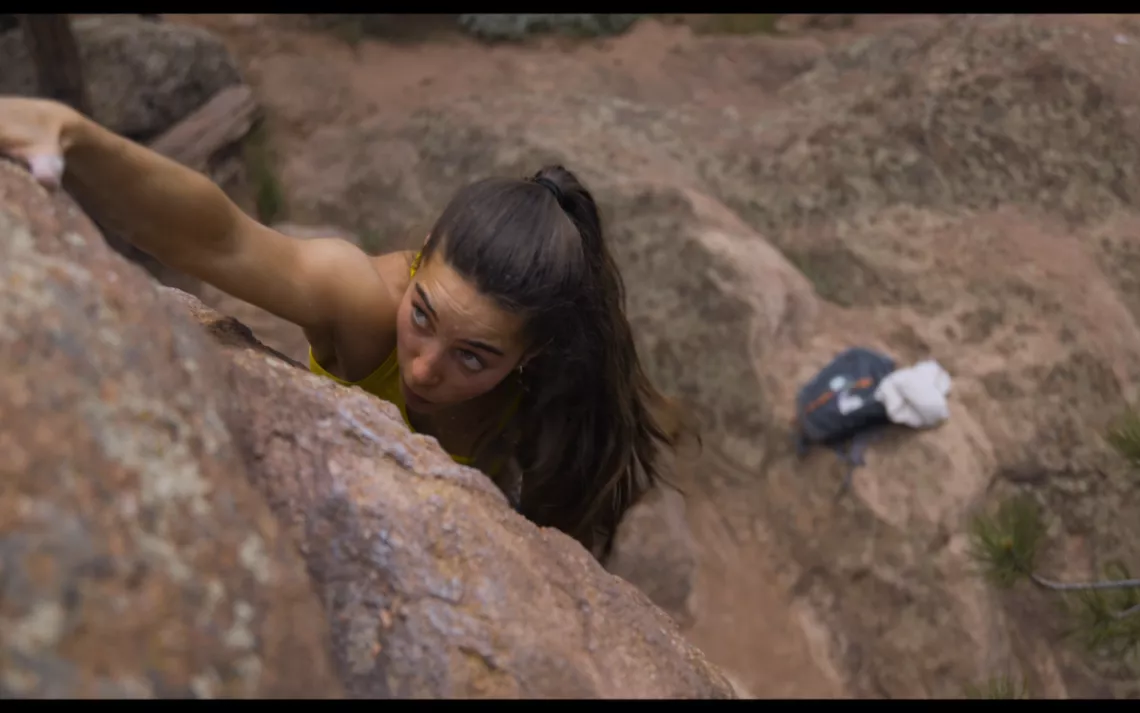“The Wall: Climb for Gold” Is a Quintessential Sports Film
The documentary offers a gripping portrait of rock climbing’s first Olympians

Photo courtesy of Windall Films
In The Wall: Climb for Gold, we meet four world-class-competition rock climbers—Great Britain’s Shauna Coxsey, Slovenia’s Janja Garnbret, Japan’s Miho Nonaka, and USA’s Brooke Raboutou—as they train for and compete in the sport’s first Olympic Games. The 90-minute documentary, produced by Windfall Films and directed by Nick Hardie, documents the physical and mental hurdles the elite climbers face as they prepare for the 2020 games in Tokyo, which were delayed a year due to COVID-19. The stakes are high: “With the Olympics, it’s like Everest appeared on the horizon,” Charlie Boscoe narrates in the film’s opening scenes. “Whoever wins the gold medal in Tokyo will be able to live off the glory of that for the rest of their lives.”
Throughout the documentary, Coxsey, Garnbret, Nonaka, and Raboutou are on display as incredibly powerful athletes, ones who also happen to be female. Refreshingly, the film does not dwell on this fact—I breathed a sigh of relief that there wasn’t any trite commentary on what it means to “be a woman” in the sport. It’s 2022—the film rightly presents these athletes as some of the best climbers in the world, without any qualifiers. Viewers will appreciate the jaw-dropping athleticism and acrobatics of the competition-style climbing, alongside sweeping scenes of the four women scaling breathtaking cliffs. Natural rock is a welcome respite from the stuffy demands of the gym. The persistent pressure of training indoors, and how the athletes cope with it, is the main through line of the documentary.
The film also explores each climber’s history and personality, delving into their strengths and weaknesses, both physical and mental. Coxsey, who remains unwaveringly positive despite persistent injuries, tells us that she “became very resilient at a young age” when her mother left her. We witness an intimate moment where she quietly cries on a gym mat.
Garnbret describes waning motivation while she waits for the Olympics to finally start and how “others made me believe that the problems shouldn’t be there” because they saw her as infallible. While training in the gym, she repeatedly falls on a move. “Could you at least try?” her coach asks with frustration. “No,” Garnbret curtly responds. The vexation is palpable.
Nonaka—who must contend with the high expectations of representing the games’ home country—is all smiles in a TV announcement. But after the cameras are off, she wipes tears away while sitting alone in a conference room. “I realize now that I was at my wit’s end,” she admits.
In an old home video, we see a baby Raboutou in a survival swim class, bobbing to face upward and breath. “There you go, Brookie-poo,” her mother says from the poolside, and we’re reminded of the legacy Raboutou has inherited—and the pressure that comes with it—as the child of two legendary climbers.
These scenes reveal the vulnerable underbelly of these athletes and the dissonance between how others view them and how they feel internally. It’s difficult to imagine a film about male climbers displaying such intense vulnerability, but it only improves the genre. Climbing documentaries, from Free Solo to the Dawn Wall, are wearily male focused. It is refreshing to watch the camera turn unquestioningly toward female competitors, with the male voices relegated to dads and coaches on the sidelines.
The film doesn't set out to address the issue of inclusion in rock climbing, and nor really should we expect it to simply because it spotlights female athletes. In this sense, The Wall: Climb for Gold follows in the footsteps of Never Not Collective’s 2020 documentary, Pretty Strong, which features eight women attempting strenuous climbs around the globe. The creators of Pretty Strong wanted to “show it, not say it” when it comes to women crushing it as climbers.
But neither should we celebrate The Wall as some kind of triumph of representation and inclusion. Visibility of female rock climbers—in this case, ones who are mostly white, and ostensibly cisgender—shouldn’t suggest to anyone that barriers to the sport have dissolved. Rock climbing is still inaccessible—consider the fact that it’s not even a Paralympic sport yet.
The context the film is missing has less to do with gender and more to do with the sport itself. Viewers—especially those who rock climb—will likely feel that The Wall comes up short in some respects. It brushes over any contextual history of rock climbing as it relates to the Olympics as well the sport’s unique disciplines and demands, except with platitudes like “climbing’s really the ultimate sport.”
Perhaps in an effort to make a technical sport more palatable to a mainstream audience, the film studiously avoids athletic commentary. I found myself wondering, What makes each of these climbers unique in terms of their climbing styles? Where do they succeed and where do they falter? How did they train? The film does not even mention how, at the Tokyo Olympics, speed climbing, bouldering, and leading climbing—competitive fields as distinct as long distance is from hurdles in track—were all combined into a single competition field, because the Olympic Committee only permitted one medal for each gender.
Instead, we are treated to a more universal struggle-and-strife narrative. No doubt, the challenges these Olympians must overcome, from injuries to mental roadblocks, are compelling, and The Wall is most engaging when it allows the audience an unvarnished view of these. Yet one can easily imagine those challenges being present in any elite athletic competition. Ultimately, The Wall is a typical sports film. For those who are looking for such a narrative, it delivers. Most rock climbers, though—for better or for worse–don’t really like to think of their sport as typical.
 The Magazine of The Sierra Club
The Magazine of The Sierra Club



